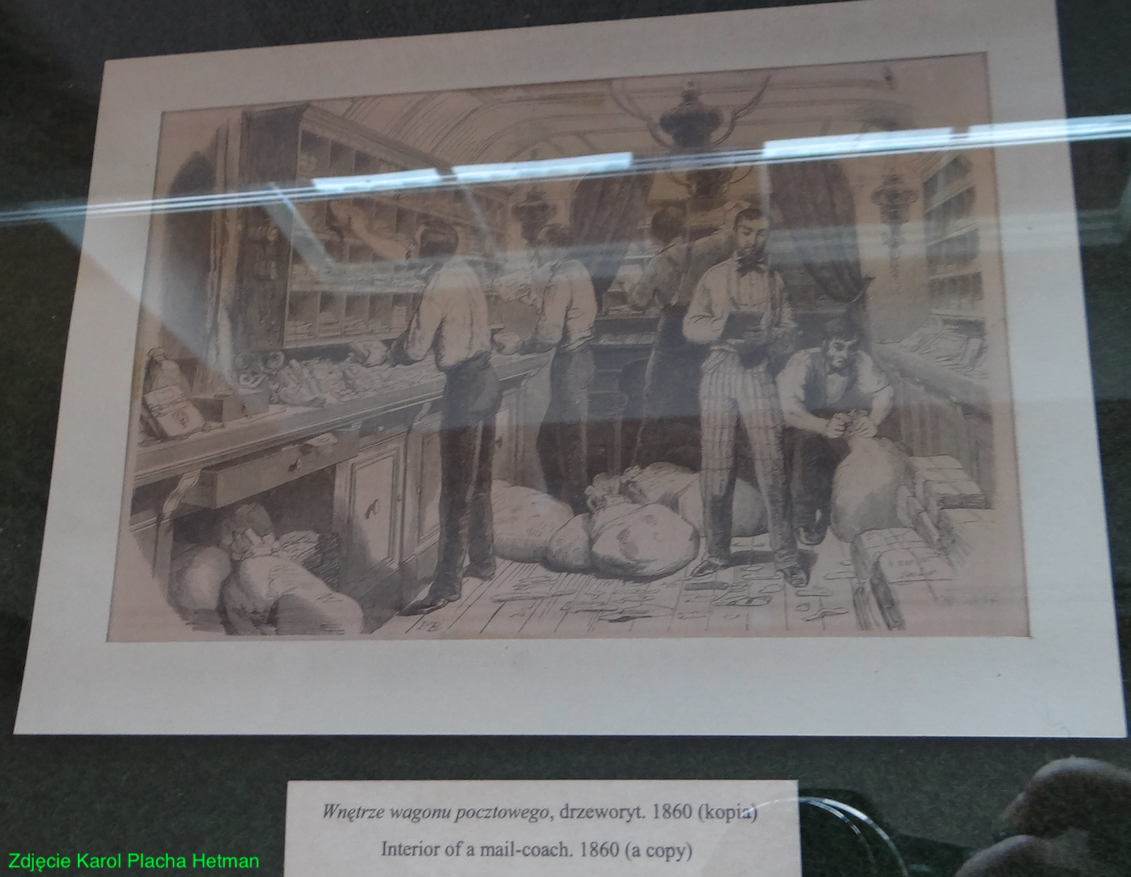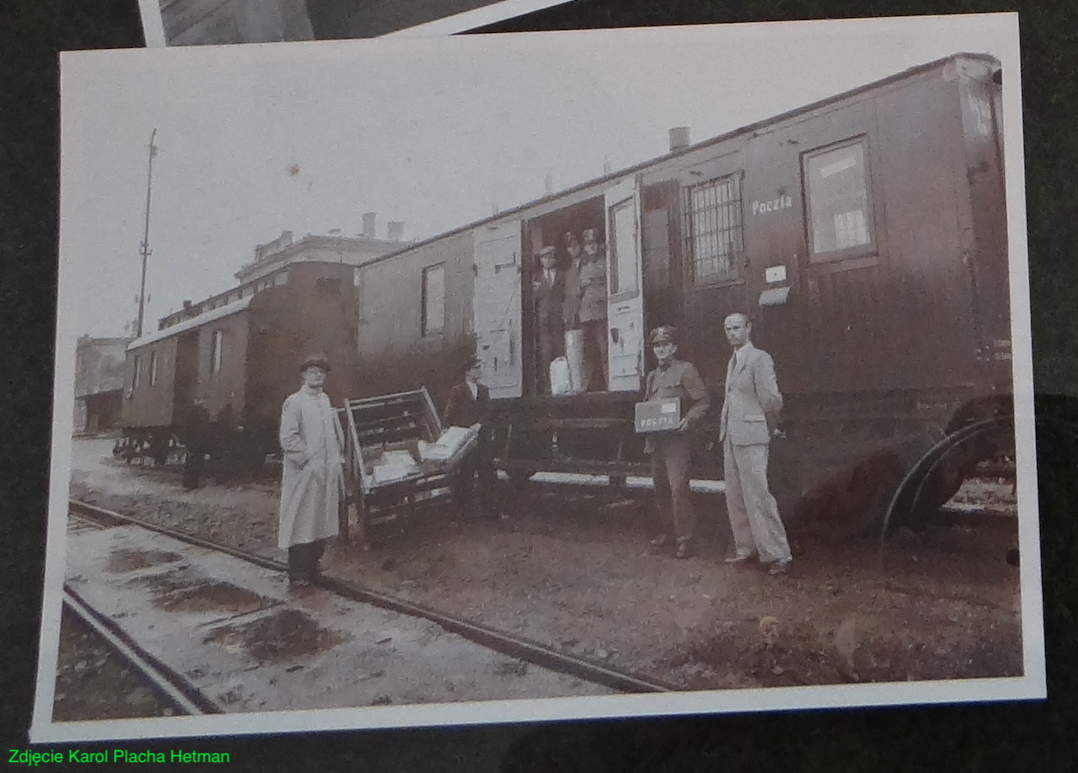Kraków 2023-08-11
Mail wagons.

Photo description: Transport of a mail wagon on a platform pulled by a horse-drawn carriage. The mail car was built by the Lilpop, Rau et Company factory in Solec in Warsaw, for the Warsaw-Petersburg Railway. 1870 year. Drawing of the post office museum.

Photo description: Working in a mail car in 1860 year. Drawing of the post office museum.

Photo Description: Photo of the post office museum.
History of postal cars.
October 18, 1558 is considered to be the date of birth of the post office in Poland. It was then that King Zygmunt August "established a permanent postal connection between Krakow and Venice via Vienna, using the post, i.e. staggered horses". The public institution established by the monarch was to serve primarily to maintain permanent diplomatic and economic contacts with other European countries. The monarchy in Poland and the monarchy in Venice were personally related, mainly through the person of Queen Bona. Maintaining constant communication between the Sforza family and the Polish King required the introduction of a regular postal connection. In the 16th century, the original duties of carrying correspondence were added to the transport of goods and people. The activities of the postal institution in Poland were financed by the King. Soon, transport tariffs were introduced and they could be used not only by the king, but also by every private person. The institution had the official name "Poczta Polska" and was divided into two parts: the Italian post office and the Lithuanian post office. Its main seat was Krakow. Cooperation with other post offices in Europe was strengthened. Over time, the institution "Poczta Polska" began to bring profits, and the king was released from its financing and used its services for free. In 1568, Sebastian Montelupi became the director of the Polish Post Office, and his family ran the institution for nearly 100 years. At that time, the right of inviolability of correspondence, both royal (diplomatic) and private, was established. In Europe, the post office was not national at that time and there were no borders for it, even in times of local armed conflicts. This attitude changed during the Great World War.
When the railways developed in the 1840s, it was clear that the railways would be used to carry mail. According to official data, the first mail car went on the tracks in England in 1838, and in France in 1840. The first journey of mail in a post car, the so-called Traveling Post Office (TPO) on a train, was recorded on January 20, 1838 in England, on the Birmingham - Warrington route.
The first transports of postal items in the Polish Territories took place as early as 1842, on the Wrocław - Gliwice route, in Germanic times. At that time, passenger and mail cars were used. In the Kingdom of Poland (Moscow Partition), the first mixed wagons for transporting mail and goods appeared in 1848 with the opening of the section of the Warsaw-Vienna Railway on the Częstochowa - Border route. In 1849, mail was transported along the entire length of the Warsaw-Vienna line. Other directions of mail transport are the Bydgoszcz Railway to the city of Aleksandrów Kujawski (towards Toruń) and to Łódź from Koluszki. Then the postal cars were introduced to the Warsaw-Petersburg Railway. Post offices were set up at all major stations. Mail wagons were then called "Kurierki". Subsequently, the mail wagons were also called "Post Ambulances". The Post Office and the Railway jointly developed regulations, rules of carriage and tariff charges. A division of responsibility was agreed.
At first, the mail wagons were just freight wagons. But soon the sorting of letters and postcards was introduced inside the carriage. At railway stations where the train did not stop, bags with letters were taken over in passing, from special hangers, through jibs put out from the postal car. This solution was not used in Poland. In France, this was a procedure often used.
In 1918, Poland regained its independence, and on February 7, 1919, a state institution was established by decree to manage postal, telegraphic and telephone services. Temporary regulations have been issued for its operation. The temporary institution took over all postal assets in Poland, including buildings, horse and car vehicles, railway cars of various sizes and track widths. Naturally, the telephone, telegraph and wireless telegraph networks, the system for distributing letters, postcards and parcels were taken over. These wagons were postal, postal and freight, postal and luggage, as well as postal and passenger cars. A significant part of these wagons required repair, and a large percentage were not even suitable for repair and were scrapped. In 1925, the institution "Polska Poczta, Telegraf i Telefon" already had 333 mail cars and 201 post-baggage and passenger cars. With each subsequent year, the number of typical postal wagons increased. Wagons of this type were produced by the Plant in Sanok. In 1930, the post office already had 435 mail cars.
Mail cars in every country in Europe were owned by the postal service, although they had to comply with railway regulations and had to undergo normal railway inspections. A technical feature of the wagons was the lack of front doors for the passage to the next wagon. It was about the safety of postmen, because they often transported money and diplomatic items. But there were exceptions when the mail car was a result of the conversion of a passenger car or was also a baggage car.
The mail car was usually placed at the front of the train, just behind the locomotive. It happened that the train had two or more mail cars. The only exceptions were postal trains.
Some mail cars had a slot in the side, into which a letter with a stamp could be dropped. The letter, of course, was thrown during stops at the stations. Letters and postcards were stamped with the stamp assigned to the postal car.
In 1955, Poczta Polska had nearly 1,000 postal carriages and was a co-owner of approximately 600 postal and passenger carriages. However, already at the beginning of the 1960s, the number of wagons began to decrease. The development of car transport contributed to this. However, the post wagons were not abandoned. Old postal cars were exchanged for modern "Y" series cars. The last new mail cars were produced in 1982. They were type 101C (PaFaWag) and similar type 304C (HCP).
Until 1994, in Poland, postal cars were painted green (dark olive), with a red stripe with a white border along the side. There was the inscription Poczta Polska and a logo, or only the inscription Poczta. From 1994, the mail cars were painted orange. A red stripe has been left below the line of windows with a white trim.
In Europe, the twilight of postal cars was caused by too long time for the delivery of postal items by the railway. Mail was delivered faster by cars and planes.
Socio-economic changes in 1989 led to the process of limiting the provision of transport services by post wagons. The trial lasted from 1992 to 2003. The liquidation of hundreds of railway connections had a major impact, and as a consequence, regional exclusions and the liquidation of many railway routes and railway stations. In November 2003, Poczta Polska ceased extensive use of railways for the transport of postal items. As a result, over 60 postal cars were taken out of service. In May 2006, the Polish Post had only 36 postal cars, of which only 15 were in motion. They operated only on a few selected long-distance routes.
In 2011, Poczta Polska ended the operation of post wagons. Currently (2023) postal items are transported only by cars. In 2011, the last four mail cars were put up for sale. They served the Polish Post Office for 30 years. The last trips were made on the route Kraków - Wrocław - Szczecin. The last run of the postal car in Poland took place on May 29, 2011, from Kraków Płaszów to Szczecin Główny.
On the railways, conductor consignments remained, which are a type of consignments carried by railway carriers using passenger trains. Parcels and letters are accepted and handed over to the train manager during the stop at the station, and their transport takes place in the service compartment. For an additional fee, sending or collecting a parcel can be carried out by stationary conductor parcel points located at selected railway stations.
Written by Karol Placha Hetman
